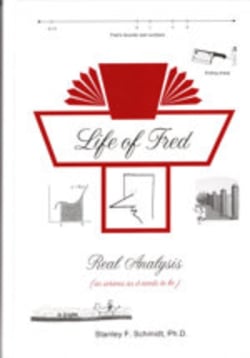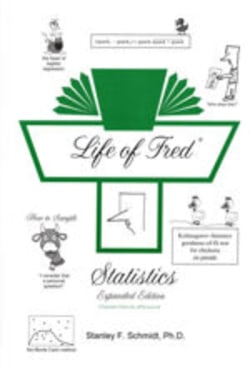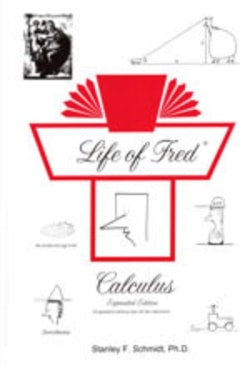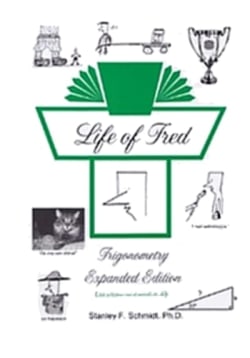Images
One day in Fred’s life in which he . . .
• Falls in Love!
• Teaches you how to write an opera!
• Buys Hecks Kitchen!
• Does all of geometry up to the 14th dimension!
Geometry is one course that is different from all the rest. In the other courses, the emphasis is on calculating, manipulating and computing answers. In contrast, in geometry there are proofs to be created. It is much more like solving puzzles than grinding out numerical answers. For example, if you start out with a triangle that has two sides of equal length, you are asked to show that it has two angles that have the same size.
You will need at least one year of high school algebra. (Life of Fred: Beginning Algebra). In this geometry book for example, on p. 26 we will go from y + y = z to y = ½ z. It is preferable, however, that you have completed the two years of high school algebra. (Life of Fred: Beginning Algebra and Life of Fred: Advanced Algebra Expanded Edition). Most schools stick geometry between the two years of algebra – beginning algebra, geometry, advanced algebra – but there are a couple of reasons why this is not the best approach.
First, when you stick geometry between the two algebra courses, you will have a whole year to forget beginning algebra. Taking advanced algebra right after beginning algebra keeps the algebra fresh.
Second, the heart of geometry is learning how to do proofs. This requires an “older mind” than the mechanical stuff in the algebra courses. A person’s brain develops in stages. Most three-year-olds don’t enjoy quiz shows on television.
In this course you will learn about…
Non-Euclidean Geometry
Attempts to prove the Parallel Postulate
Nicolai Ivanovich Lobachevsky’s geometry
Consistent Mathematical theories
Georg Friedrich Bernhard Riemann’s geometry
Geometries with only three points
Points and Lines
Attempts to prove the parallel postulate
Collinear points
Concurrent lines
Coplanar lines
Coordinates of a point
Definition of when one point is between two other points
Exterior Angles
Indirect Lines
Line segments
Midpoint
Parallel lines
Perpendicular Lines
Perpendicular Bisectors
Postulates and theorems
Skew lines
Distance from a point to a Line
Tangent and secant lines
Theorems, propositions, lemmas, and corollaries
Undefined terms
Quadrilaterals
Honors Problem of the century:
If two angle bisectors are congruent
when drawn to the opposite sides,
then the triangle is isosceles
Intercepted segment
Kite
Midsegment of a triangle
Parallelogram
Rectangle
Rhombus
Square
Trapezoid
Solid Geometry
Euler’s theorem
A line perpendicular to a plane
Distance from a point to a plane
Parallel and perpendicular planes
Polyhedrons
hexahedron (cube)
tetrahedron
Octahedron
Icosahedron
Dodecahderon
Volume Formulas: cylinders, prisms,
cones, pyramids, spheres
Cavalieri’s Principle
Lateral Surface Area
Symbolic Logic
Contrapositives
If…then…statements
Truth tables
Triangles
Acute and Obtuse Triangles
Adjacent, opposite, hypotenuse
Altitudes
Angle bisector theorem
Definition of a triangle
Drawing auxiliary lines
equilateral and equiangular triangles
Hypotenuse-leg theorem
Isosceles triangle theorem
Medians
Pons Asinorum
Proof that a right angle is congruent
to an obtuse angle using euclidean geometry
Proportions
Right Triangles
Scalene Triangles
Similar triangles
SSS, SAS, ASA postulates
Angles
Acute, obtuse, and right angles
Alternate interior angles and corresponding angles
Congruent angles
Degrees, minutes, and seconds
Euclid’s The Elements
Exterior angles
Inscribed angle theorem
Linear pairs
Rays
Supplementary angles
Two proofs of the exterior angle theorem
Vertical angles
Area
Area and volume formulas
Heron’s Formula
Parallelograms
Perimeter
Polygons
Pythagorean Theorem
Rectangles, Rhombuses, and Squares
Trapezoids
Triangle inequality
Triangles
Circles
Center, radius, chord, diameter, secant, tangent
Concentric circles
Central Angles
Circumference
Arcs
Inscribed angles
Proof by Cases
Sectors
Constructions
Compass and straightedge
Rules of the Game
Rusty compass constructions
Golden Rectangles and golden ratio
Trisecting an angle and squaring a circle
Incenter and circumcenter of a triangle
Collapsible compass constructions
46 popular constructions
Coordinate Geometry
Analytic geometry
Cartesian/rectangular/orthogonal coordinate system
Axes, origins, and quadrants
slope
distance formula
midpoint formula
proofs using analytic geometry
Flawless (Modern) Geometry
Proof that every triangle is isosceles
Proof that an obtuse angle is congruent to a right angle
19-year-old Robert L Moore’s modern geometry
Geometry in Dimensions
Geometry in Four Dimensions
Geometry in high dimensions
Complete chart up to the 14th dimension
Stereochemistry and homochirality
Five manipulations of proportions
tesseracts and hypertesseracts
Polygons
Definition of a polygon
Golden rectangles
Proofs
Proof of a theorem in paragraph form
Hypothesis and conclusion
Indirect proofs
Hunch, hypothesis, theory, and law
Proofs of all the area formulas given
only the area of a square (This is hard.
Most books start with the area of
a triangle as given.)
Proofs of the Pythagorean theorem
Definition of a limit of a function
Inductive and deductive reasoning
Proofs using geometry
Unlike all other math programs, this one also has:
• The only verse of Fred’s famous song, “Another Day, Another Ray”
• The difference between iambic, trochaic, anapestic and dactyllic in poetry
• How easy it is to confuse asinorum which is in the genitive plural in Latin with asinus which is in the nominative singular.
• A good use for Prof. Eldwood’s Introduction to the Poetry of Armenia while on the deck of a pirate ship
All answers are included in the textbook.
Similar resources
The Life of Fred homeschool math books cover math topics appropriate for kindergarteners all the way up to third year of college, including arithmetic, fractions and decimals, algebra, geometry, calculus, and everything in between.
No other textbooks are like these. Each text is written in the style of a novel with a humorous story line. Each section tells part of the life of Fred Gauss and how, in the course of his life, he encounters the need for the math and then learns the methods. Tons of solved examples. Each hardcover textbook contains ALL of the material – more than most instructors cover in traditional classroom settings. Includes tons of proofs.
Written by Dr. Stanley Schmidt with the intent to make math come alive with lots of humour, clear explanations, and silly illustrations that stick in the mind. The student will learn to think mathematically.
Completion of this series prepares student for third year college math.


Life of Fred: Real Analysis

Life of Fred: Linear Algebra Expanded Edition

Life of Fred: Statistics, Expanded Edition

Life of Fred Calculus: Expanded Edition

Life of Fred Trigonometry Expanded Edition














